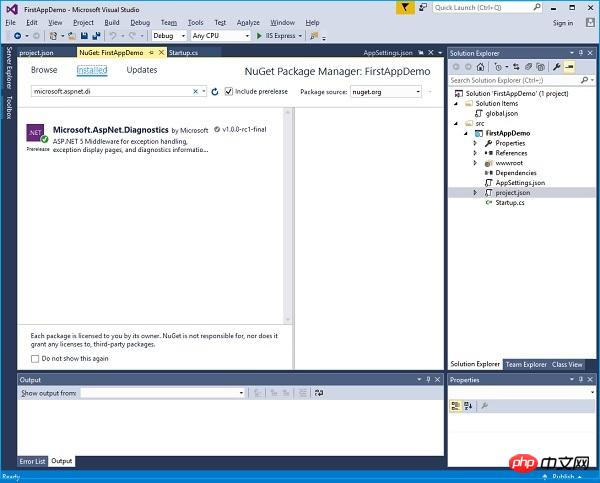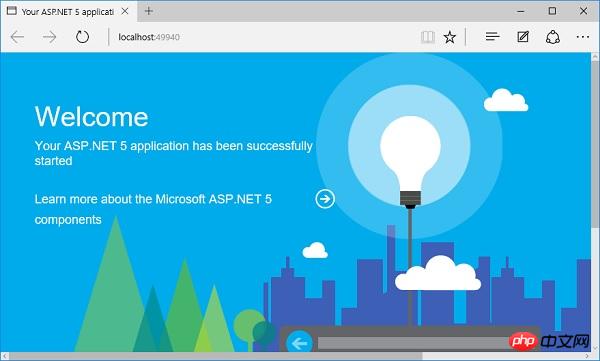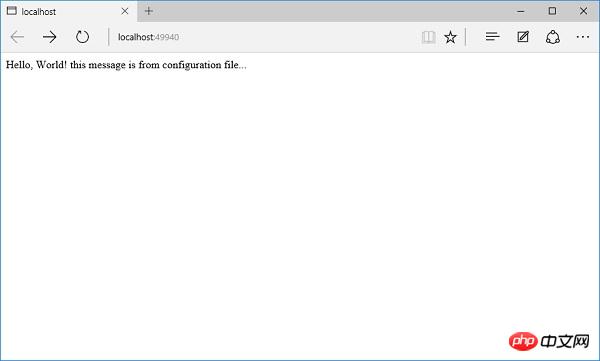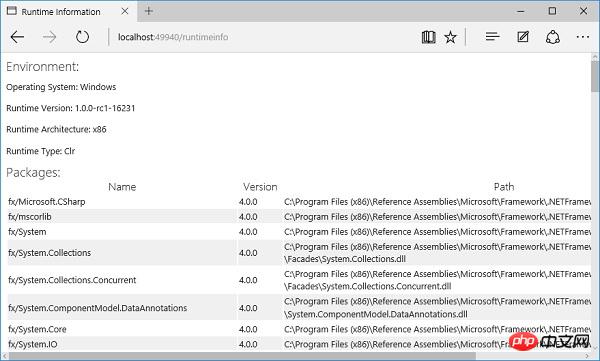ASP.NET Coreミドルウェア設定チュートリアル(7)_実践ヒント
この記事では、主に ASP.NET CoreMiddleware の設定チュートリアルを詳しく紹介します。興味のある方は、
Asp.Net Core-Middleware
- ミドルウェアは、リクエストと応答を処理するためにアプリケーションのパイプラインに組み込まれるソフトウェア コンポーネントです。
- 各コンポーネントは、パイプライン内の次のコンポーネントにリクエストを渡すかどうかを選択でき、パイプライン内のタスクの前後に特定のアクションを実行できます。
- リクエストデリゲートは、リクエストパイプラインを構築するために使用されます。リクエスト デリゲートは、各 HTTP リクエストを処理するために使用されます。
- ASP.NET Core のミドルウェアのすべての部分はオブジェクトであり、各部分には非常に具体的で焦点が絞られた限定された役割があります。
- 最終的には、アプリケーションに適切な動作を提供するために多くのミドルウェアが必要になります。
- この場合、アプリケーションに
インストールする最初のミドルウェアはログコンポーネントです。
- このロガーはすべての受信リクエストを確認でき、ミドルウェアは情報をログに記録し、このリクエストを次のブロックのミドルウェアに渡します。

- ミドルウェアは、この処理パイプラインに一連のコンポーネントとして表示されます。
- アプリケーションにインストールする次のミドルウェアは、認可コンポーネントです。
- コンポーネントは、特定の
- 認可コンポーネントがトークンを見つけた場合、リクエストの続行が許可されます。
- そうでない場合、認可コンポーネント自体が HTTP エラー コードでリクエストに応答するか、ユーザーをログイン ページにリダイレクトする可能性があります。
- それ以外の場合、認可コンポーネントはリクエストを次のルーターのミドルウェアに渡します。
- ルーターは URL を見て、次のアクションを決定します。
- ルーターがいくつかの応答を行っているが、応答が見つからない場合、ルーター自体が 404 Not Found エラーを返す可能性があります。
の場合
using Microsoft.AspNet.Builder;
using Microsoft.AspNet.Hosting;
using Microsoft.AspNet.Http;
using Microsoft.Extensions.DependencyInjection;
using Microsoft.Extensions.Configuration;
namespace FirstAppDemo {
public class Startup {
public Startup() {
var builder = new ConfigurationBuilder()
.AddJsonFile("AppSettings.json");
Configuration = builder.Build();
}
public IConfiguration Configuration { get; set; }
// This method gets called by the runtime.
// Use this method to add services to the container.
// For more information on how to configure your application,
// visit http://go.microsoft.com/fwlink/?LinkID=398940
public void ConfigureServices(IServiceCollection services) {
}
// This method gets called by the runtime.
// Use this method to configure the HTTP request pipeline.
public void Configure(IApplicationBuilder app) {
app.UseIISPlatformHandler();
app.Run(async (context) => {
var msg = Configuration["message"];
await context.Response.WriteAsync(msg);
});
}
// Entry point for the application.
public static void Main(string[] args) => WebApplication.Run<Startup>(args);
}
}IISPlatformHandler
app.Run に登録されたミドルウェア
ミドルウェアを追加する方法
Microsoft.aspnet.diagnostics を検索します。この特定のパッケージには、使用できるさまざまな種類のミドルウェアが含まれています。
 ステップ 3-パッケージがプロジェクトにインストールされていない場合は、このパッケージをインストールすることを選択します。
ステップ 3-パッケージがプロジェクトにインストールされていない場合は、このパッケージをインストールすることを選択します。
ステップ 4− 次に、Configure() メソッドで app.UseWelcomePage ミドルウェアを呼び出します。
// This method gets called by the runtime.
// Use this method to configure the HTTP request pipeline.
public void Configure(IApplicationBuilder app) {
app.UseIISPlatformHandler();
app.UseWelcomePage();
app.Run(async (context) => {
var msg = Configuration["message"];
await context.Response.WriteAsync(msg);
});ステップ5 *-アプリケーションを実行すると、次のようこそ画面が表示されます。
 このようこそ画面はあまり役に立たないかもしれません。
このようこそ画面はあまり役に立たないかもしれません。
步骤6−让我们试试别的东西,可能是更有用的,而不是使用欢迎页面,我们将使用RuntimeInfoPage。
// This method gets called by the runtime.
// Use this method to configure the HTTP request pipeline.
public void Configure(IApplicationBuilder app) {
app.UseIISPlatformHandler();
app.UseRuntimeInfoPage();
app.Run(async (context) => {
var msg = Configuration["message"];
await context.Response.WriteAsync(msg);
});
}第 7 步 − 保存您的 Startup.cs 页面并刷新您的浏览器,你会看到下面的页面。

这个 RuntimeInfoPage 是中间件,将只响应一个特定的 URL 的请求。如果传入的请求与该 URL 不匹配,这个中间件只是让请求传递到下一件中间件。该请求将通过 IISPlatformHandler 中间件,然后转到 UseRuntimeInfoPage 中间件。它不会创建响应,所以它会转到我们的应用程序。运行并显示该字符串。
步骤8−我们在URL结尾添加“ runtimeinfo”。现在,您将看到一个页面,该页面是由中间件运行时信息页面。

你将看到一个返回页面,它给你展示了一些关于你的运行时环境,如操作系统、运行时版本,结构,类型和您正在使用的所有包的信息。
以上がASP.NET Coreミドルウェア設定チュートリアル(7)_実践ヒントの詳細内容です。詳細については、PHP 中国語 Web サイトの他の関連記事を参照してください。

ホットAIツール

Undresser.AI Undress
リアルなヌード写真を作成する AI 搭載アプリ

AI Clothes Remover
写真から衣服を削除するオンライン AI ツール。

Undress AI Tool
脱衣画像を無料で

Clothoff.io
AI衣類リムーバー

AI Hentai Generator
AIヘンタイを無料で生成します。

人気の記事

ホットツール

メモ帳++7.3.1
使いやすく無料のコードエディター

SublimeText3 中国語版
中国語版、とても使いやすい

ゼンドスタジオ 13.0.1
強力な PHP 統合開発環境

ドリームウィーバー CS6
ビジュアル Web 開発ツール

SublimeText3 Mac版
神レベルのコード編集ソフト(SublimeText3)

ホットトピック
 7532
7532
 15
15
 1379
1379
 52
52
 82
82
 11
11
 21
21
 79
79
 Tomcatミドルウェアの原理は何ですか
Dec 27, 2023 pm 04:40 PM
Tomcatミドルウェアの原理は何ですか
Dec 27, 2023 pm 04:40 PM
Tomcat ミドルウェアの原理は、Java Servlet および Java EE 仕様に基づいて実装されています。 Tomcat はサーブレット コンテナとして、HTTP リクエストとレスポンスを処理し、Web アプリケーションに実行環境を提供する役割を果たします。 Tomcat ミドルウェアの原理には主に次のものが含まれます: 1. コンテナ モデル; 2. コンポーネント アーキテクチャ; 3. サーブレット処理メカニズム; 4. イベント リスニングとフィルター; 5. 構成管理; 6. セキュリティ; 7. クラスタリングとロード バランシング; 8. コネクタテクノロジー; 9. エンベデッドモードなど
 Laravelでデータ高速化のためのミドルウェアを使用する方法
Nov 02, 2023 am 09:40 AM
Laravelでデータ高速化のためのミドルウェアを使用する方法
Nov 02, 2023 am 09:40 AM
Laravel でデータ アクセラレーションのためのミドルウェアを使用する方法 はじめに: Laravel フレームワークを使用して Web アプリケーションを開発する場合、データ アクセラレーションがアプリケーションのパフォーマンスを向上させる鍵となります。ミドルウェアは、Laravel が提供する重要な機能で、リクエストがコントローラーに到達する前、または応答が返される前に処理します。この記事では、ミドルウェアを使用して Laravel でデータ高速化を実現する方法に焦点を当て、具体的なコード例を示します。 1. ミドルウェアとは何ですか? ミドルウェアはLaravelフレームワークの仕組みです。
 Laravelでのレスポンス変換にミドルウェアを使用する方法
Nov 03, 2023 am 09:57 AM
Laravelでのレスポンス変換にミドルウェアを使用する方法
Nov 03, 2023 am 09:57 AM
Laravel での応答変換にミドルウェアを使用する方法 ミドルウェアは、Laravel フレームワークの非常に強力で実用的な機能の 1 つです。これにより、リクエストがコントローラーに入る前、またはレスポンスがクライアントに送信される前に、リクエストとレスポンスを処理できるようになります。この記事では、Laravel でレスポンス変換にミドルウェアを使用する方法を説明します。始める前に、Laravel がインストールされており、新しいプロジェクトが作成されていることを確認してください。次に、次の手順に従います。 新しいミドルウェアを作成する 開く
 Laravelでミドルウェアを使用してフォーム検証を処理する方法
Nov 02, 2023 pm 03:57 PM
Laravelでミドルウェアを使用してフォーム検証を処理する方法
Nov 02, 2023 pm 03:57 PM
ミドルウェアを使用して Laravel でフォーム検証を処理する方法、特定のコード例が必要です はじめに: フォーム検証は Laravel で非常に一般的なタスクです。ユーザーが入力したデータの有効性と安全性を確保するために、当社は通常、フォームに送信されたデータを検証します。 Laravel は便利なフォーム検証機能を提供しており、フォーム検証を処理するためのミドルウェアの使用もサポートしています。この記事では、ミドルウェアを使用してLaravelでフォーム検証を処理する方法を詳しく紹介し、具体的なコード例を示します。
 Laravelでスケジュールされたタスクのスケジューリングにミドルウェアを使用する方法
Nov 02, 2023 pm 02:26 PM
Laravelでスケジュールされたタスクのスケジューリングにミドルウェアを使用する方法
Nov 02, 2023 pm 02:26 PM
Laravel でスケジュールされたタスクのスケジューリングにミドルウェアを使用する方法 はじめに: Laravel は、Web アプリケーションを開発するための便利で強力なツールを提供する、人気のある PHP オープン ソース フレームワークです。重要な機能の 1 つはスケジュールされたタスクです。これにより、開発者は指定された間隔で特定のタスクを実行できます。この記事では、ミドルウェアを使用してLaravelのスケジュールされたタスクのスケジューリングを実装する方法と、具体的なコード例を紹介します。環境の準備 始める前に確認する必要があります
 Slim フレームワークのミドルウェアを使用してクロスドメイン リソース共有 (CORS) を設定する方法
Jul 30, 2023 pm 08:34 PM
Slim フレームワークのミドルウェアを使用してクロスドメイン リソース共有 (CORS) を設定する方法
Jul 30, 2023 pm 08:34 PM
Slim フレームワークでミドルウェアを使用してクロス オリジン リソース シェアリング (CORS) を設定する方法 クロス オリジン リソース シェアリング (CORS) は、サーバーが HTTP 応答ヘッダーに追加情報を設定して、ブラウザーに相互接続を許可するかどうかを伝えることができるメカニズムです。 -オリジンリクエスト。フロントエンドとバックエンドが分離されている一部のプロジェクトでは、CORS メカニズムを使用して、バックエンド インターフェイスに対するフロントエンドのクロスドメイン要求を実現できます。 Slim フレームワークを使用して REST API を開発する場合、ミドルウェア (Middleware) を使用できます。
 Laravelでデータ復元用のミドルウェアを使用する方法
Nov 02, 2023 pm 02:12 PM
Laravelでデータ復元用のミドルウェアを使用する方法
Nov 02, 2023 pm 02:12 PM
Laravel は、効率的で安全かつスケーラブルな Web アプリケーションを構築するための多くの高速かつ簡単な方法を提供する、人気のある PHP Web アプリケーション フレームワークです。 Laravel アプリケーションを開発する場合、多くの場合、データ回復の問題、つまり、データの損失または損傷が発生した場合にデータを回復し、アプリケーションの通常の動作を保証する方法を考慮する必要があります。この記事では、Laravelミドルウェアを使用してデータ回復機能を実装する方法と、具体的なコード例を紹介します。 1. ララとは何ですか?
 PHPのリアルタイム通信機能とメッセージプッシュミドルウェアの関係の分析
Aug 10, 2023 pm 12:42 PM
PHPのリアルタイム通信機能とメッセージプッシュミドルウェアの関係の分析
Aug 10, 2023 pm 12:42 PM
PHPのリアルタイム通信機能とメッセージプッシュミドルウェアの関係の分析 インターネットの発展に伴い、Webアプリケーションにおけるリアルタイム通信機能の重要性がますます高まっています。リアルタイム通信により、ユーザーはアプリケーション内でリアルタイムにメッセージを送受信できるようになり、リアルタイム チャット、即時通知などのさまざまなシナリオに適用できます。 PHP の分野では、リアルタイム通信機能を実装する方法は数多くありますが、一般的な方法の 1 つはメッセージ プッシュ ミドルウェアを使用することです。この記事では、PHPのリアルタイム通信機能とメッセージプッシュミドルウェアの関係と、メッセージプッシュの利用方法について紹介します。




